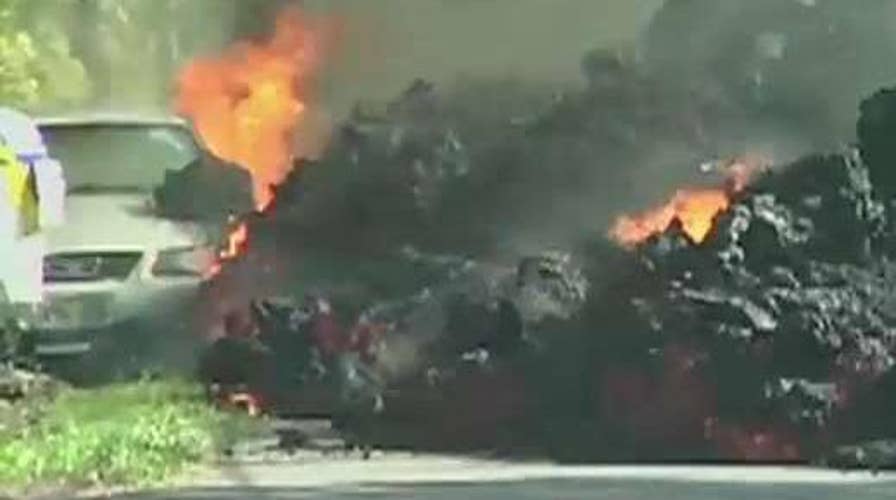Lava engulfs cars, homes on Hawaii's Big Island
Molten rock flows into Leilani subdivision; William La Jeunesse reports from Hawaii.
For days, Hawaii's Kilauea volcano has devastated the Big Island, oozing chunks of 2,000-degree lava and opening more than a dozen cracks (fissures) in the ground that spit out toxic gas and steam. Now residents are preparing for another threat: Kilauea could explode.
Geologists issued a second "orange alert" Wednesday, meaning there's a strong possiblity the volcano will blow in the coming weeks — maybe even sooner. Hawaii Volcanoes National Park is closing Friday in anticipation of a potential explosive event.
"The steady lowering of the lava lake in 'overlook crater' within Halemaʻumaʻu at the summit of Kīlauea Volcano has raised the potential for explosive eruptions," the U.S. Geological Survey (USGS) warned in an alert Wednesday. "If the lava column drops to the level of groundwater beneath Kīlauea Caldera, influx of water into the conduit could cause steam-driven explosions."
So far, Kilauea's slow-moving lava has devoured 36 structures — including 26 homes — in the Leilani Estates and Lanipuna Gardens neighborhoods since it erupted May 3. More than 1,000 residents in the area were told to evacuate and warned about the health hazards of volcanic smog caused by sulfur dioxide released through fissures.
HAWAII'S VOLCANIC ERUPTION HAS DESTROYED AT LEAST 26 HOMES, OFFICIALS SAY
If Kilaue's eruption turns explosive, the damage could be catastrophic. Ash, sulfur dioxide gas, steam and boulders up to 2 yards in diameter would shoot out of its summit crater less than a mile away, the USGS said.
It could also send pebbles shooting into the air several miles away, the agency said. Distant communities such as Hilo, about 30 miles away, could even get a dusting of ash.
Here's what you need to know about explosive eruptions in the event one strikes.
How could the volcanic eruption turn explosive?
This event could occur again when the summit lava lake drops so low that groundwater can flow into the conduit that feeds magma to the crater. The magma would heat the water and create steam which would then push accumulated rocks out in an explosion.
But explosive events are hard to predict.
HAWAII VOLCANO MAY THREATEN GEOTHERMAL POWER PLANT; DOZENS OF HOMES DESTROYED
"Steam-driven explosions at volcanoes typically provide very little warning," the USGS warned. "Once the lava level reaches the groundwater elevation, onset of continuous ashy plumes or a sequence of violent steam-driven explosions may be the first sign that activity of concern has commenced."
Has Kilauea ever had an explosive eruption?
Yes. Kilauea is one of the most active volcanoes in the country — with 34 eruptions in the past 66 years — but the Big Island hasn't seen an explosive eruption since 1924, when eruption spewed ash 20,000 feet above sea level and 10-ton rocks into the sky, leaving one man dead. The "steam-powered eruption caused more than 50 explosions over two and a half weeks," according to National Geographic.
Scientists are starting to see similarities between Kilauea's present day behavior and that of the 1924 event.
How would this compare to the 1980 eruption of Mount St. Helens?
Unlike Washington state's Mount St. Helens, Kilauea is a "shield volcano," a dome-shaped volcano built almost entirely by lava flows.
"Shield volcanoes spew lava that is comparatively thinner and runnier than stratovolcanoes," The Washington Post explained, adding it's less dangerous than other types of volcanoes. "The result is that gas can more easily escape, so their eruptions tend to be less dramatic."
Mount St. Helens, on the other hand, is a composite volcano, or stratovolcano, "a term for steep-sided, often symmetrical cones constructed of alternating layers of lava flows, ash, and other volcanic debris," the USGS explained in a post online.
The tall, snow-capped volcano is more likely to have explosive eruptions because of its shape.
"Composite volcanoes tend to erupt explosively and pose considerable danger to nearby life and property," the USGS said, adding that Hawaii's volcanoes are known for their long-flowing lava and active fissures.
Based on this information, it's unlikely Hawaii's Kilauea explosion would compare to Mount St. Helens' tragic explosion, which left 57 people dead.
Like Kilauea, Mount St. Helens experienced a series of small earthquakes followed by a magnitude 5.1 quake. The large quake, however, caused a giant landslide — "the largest debris avalanche on Earth in recorded history," according to the USGS. The landslide destroyed the volcano's northern flank (side) and cryptodome (a bulge of magma inside the volcano).
HAWAII KILAUEA VOLCANO'S ACTIVE HISTORY, AND THE SCIENCE BEHIND THE MOST RECENT ERUPTION
"The cryptodome was a very hot and highly pressurized body of magma. Its removal resulted in immediate depressurization of the volcano's magmatic system and triggered powerful eruptions that blasted laterally through the sliding debris and removed the upper 300 m (nearly 1,000 ft) of the cone," the USGS explained.
Since then, geologists have updated their technology and prepared for life-threatening explosions
“It was a watershed event in volcanology in a lot of ways,” John Pallister, the head of the USGS Volcano Disaster Assistance Program, told PBS NewsHour in 2015. “It was when geologists after the eruption worldwide started recognizing these giant debris avalanches, these giant landslides that are now recognized as a major hazard at volcanoes all around the world."
Drones, remote instruments like the USGS spider, creepmeters, strainmeters and tiltmeters help scientists better monitor volcanoes in the hopes history doesn't repeat itself.
“Now we should have good warning before it happens,” Pallister said. “And once we see the warning signs, we’ll know better when an eruption will occur.”
The Associated Press contributed to this report.





















